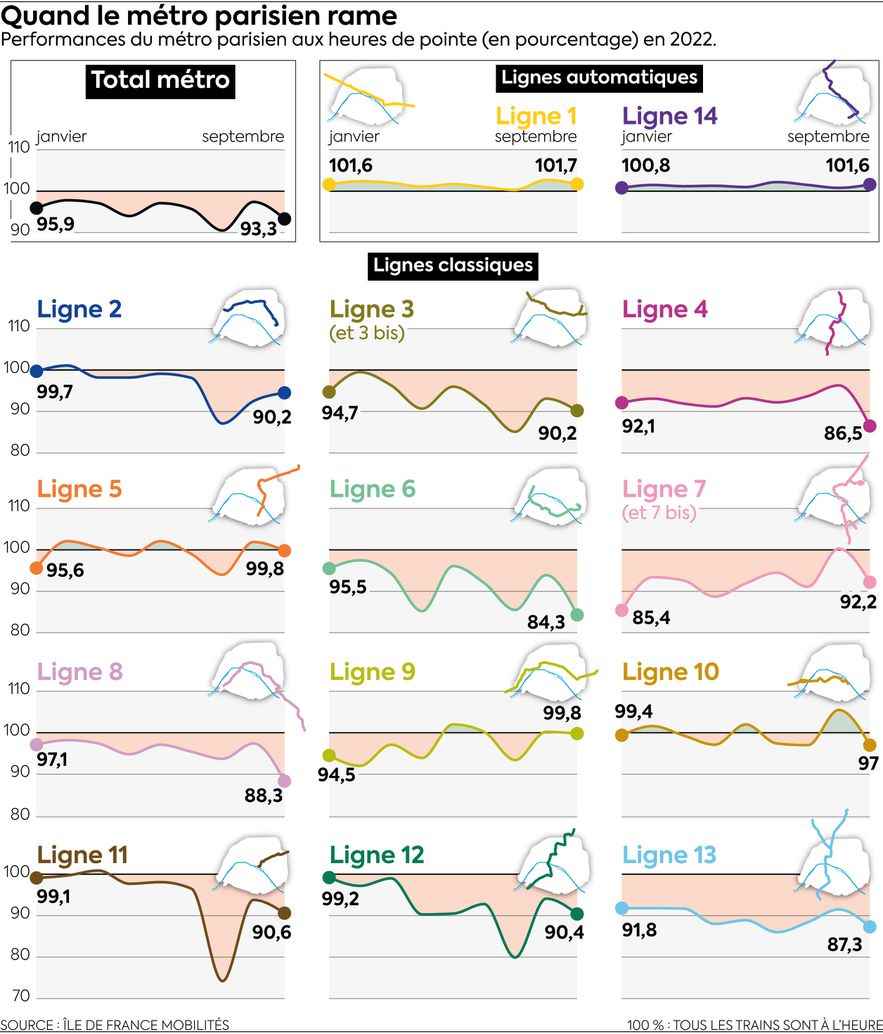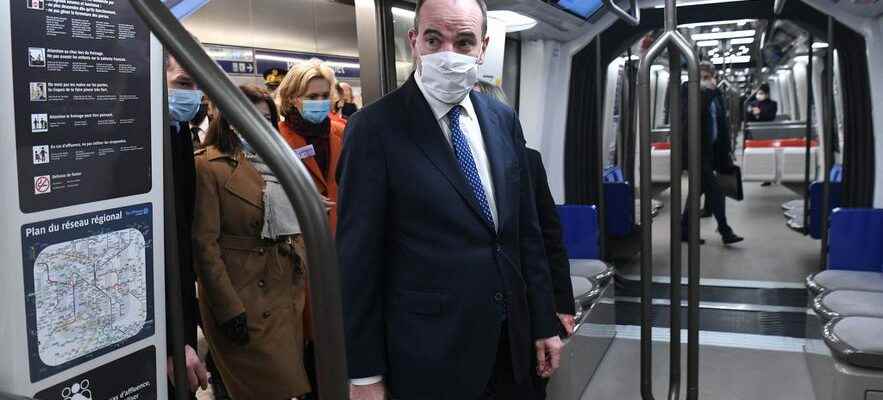For them, it’s the beginning of a long road. At the beginning of December, in an old red brick building in the 20th arrondissement of Paris, a handful of apprentice metro drivers are waiting. One by one, they will parade part of the night in the cabin of the virtual line 99 of the Paris metro. “Thanks to this simulator, we can rehearse more than 200 scenarios. Faced with the needs of the company, we have doubled the sessions to train 500 people next year. In the last fortnight alone, we have received more than 1 000 applications”, explains Laurent Lavergne, director of metro training at RATP. The manager estimates that on average 1 out of 10 candidates will join the workforce, after a course that combines theoretical safety courses (a real directory!) and eliminatory technical exercise. Recruits who will take six months to be operational, which gives RATP hope for a return to normal life on its lines by the first quarter of 2023.
Because, since last summer, it’s been a mess in Ile-de-France transport. And it all started on bus lines in the outer suburbs, where machinists are worried about the effects of opening up to competition on their working conditions. “Usually it is rather the SNCF the problem, there the concern came from the RATP”, confirms a regional source. Untimely stoppage, chronic absenteeism, in the end these are long waiting times for disillusioned users. A situation deemed “catastrophic” by elected officials from the Ile-de-France region, who noted, Valérie Pécresse in the lead, the 25% reduction in the transport offer at the start of the school year. Logically, the operators were quickly summoned by the organizing authority, Ile-de-France Mobilités (IDFM), and all justified themselves by denouncing their difficulty in recruiting.
At the RATP, the management indicated that it lacked 1,500 machinists for its buses. At the end of the year, it reached the bar of 1,200 recruits. “Absenteeism for illness is starting to decrease. In November, we are at 80% of orders made”, defends the management of the Régie. But why such a gap in the workforce? “The operators were surprised by the levels of attendance, especially during peak periods. However, transport plans are drawn up a year in advance and leave little room for flexibility”, explains Arnaud Aymé, transport specialist at the SIA Partners firm. Indeed, at the end of the pandemic, with the teleworking effect, the Region had only ordered a transport plan at 90% of pre-Covid levels. However, inflation also came to hit a chaotic recovery.
Increase in the Navigo Pass, “yes it’s bad timing”
With a gross annual salary of 26,000 euros, the RATP is still looking and having a hard time finding 40 metro drivers (out of 3,000) to provide its normal service. “Overall, the profession has deteriorated. In maintenance, entry wages are at the minimum wage, drivers work 8-hour days paid for 7:30 a.m. because of delays on the line. And management does not granted only a 2.2% salary increase in July. We are far from inflation”, deplores pell-mell Thomas Truffat, deputy secretary general of the Unsa rail pole. Added to this is the effect of resignations, in all strata of the company. According to our information, a hundred executives left the group last year, and more than 400 operators. Figures which “will be much more important in the 2022 social report”, warns another union source.
“Punctuality, regularity, cleanliness, security, quality of information, ticketing work, the diversification operated by the RATP makes sense but should not divert from our priority mission”, explained Jean Castex during his hearing in the Senate for become CEO of RATP.
© / The Express
Meanwhile, among SNCF colleagues, the regular walkouts launched in turn by drivers, controllers and switchers to influence wage negotiations are compounded with the effects of work on the network. “On RER B and D, we are suffering the consequences of aging infrastructure, particularly in the Gare du Nord and Châtelet tunnels. If we add incivility, which is on the rise, this is the effect snowball”, explains Sylvie Charles, the director of Transilien, which has a punctuality rate of 91.6% at the end of September. Abandoned bags, blocked doors or malicious acts, “these social facts weigh a quarter of the causes of non-punctuality each month”, we add at Transilien.
Only, the debt of Ile-de-France Mobilités having doubled since the Covid to reach 6 billion euros, the Region has just recorded this week an increase in the price of the Pass Navigo. A time envisaged at 90 euros per month, the monthly subscription will increase to 84.20 euros (+ 12%) in 2023, amortized by a financial extension of 200 million euros from the State. A new blow for travel associations. “Yes, it’s bad. People say to themselves ‘it’s getting worse and I’m going to have to pay more’. As a result, some want to cancel their subscription, or even cheat. In any case, there is anger”, confides Marc Pélissier , President of the Ile-de-France Transport Users Association. While possible power outages on the network in early 2023 could further darken the picture, the mess has cascading effects on Parisian mobility. Calling out on strike days, the modal shift to VTCs or taxis is a reality. However, these services, taken by storm, are not calibrated to accommodate survivors of public transport. And they too lack arms.
VTC: revenue up and number of drivers down
On the VTC market, the prefecture currently only lists 27,000 active drivers in Ile-de-France, compared to 33,000 in 2019. A tension which is combined with the effects of the mobility orientation law which obliges platforms to display the distance and the price of each trip. The drivers therefore took over. “After the yellow vests, many stopped the job. And those who are still working have become more selective about their races”, recognizes Julien Mouyeket, the manager of the Bolt platform, second operator in France behind Uber. At the American VTC giant, where customer waiting times have increased by 15% in three years, the potential of the Parisian market is estimated at 40,000 VTC drivers. However, access to the profession is filtered by extended administrative delays (from ten to twelve months to obtain a professional card after passing the exam!) from the prefectures. Uber, which onboarded 7,500 new drivers in 2022, is still waiting for 6,000 successful exam candidates to get their cards. However, the law sets a maximum deadline of three months for delivery.

Infographics
© / Dario Ingiusto / L’Express
Would the administration be worried about the number of files submitted to request sesames by way of equivalence? Indeed, according to our information, two-thirds of the cards issued at this time are assigned to paramedics, carriers… and even bus or metro drivers, all professions exempt from examination. Drivers who often seek to supplement their end of the month in the VTC. Because, for lack of drivers, “since 2019, the average price of a race has gone from an average of 15.30 euros to 22.10 euros. Their income has increased by 40%”, explains the manager of Bolt France. “Indeed, more and more agents are forced to have a second job to compensate for inflation. It’s a well-established phenomenon,” says a union source at RATP. A complementary activity that is not illegal if it respects the driver’s break time. But who controls?
Among the competitors of the Parisian taxi (18,500 active licenses), it is also confirmed that bus or metro drivers come to work for a few hours thanks to this equivalence system. And there too the workforce is lacking, while activity is sustained. “We are going to end 2022 with a business volume of 500 million euros, that’s 20% more than in 2019. To meet demand, we have suggested to the public authorities to double the number of licenses. We We are still awaiting their response”, confides Yann Ricordel, the deputy general manager of G7, the leader of the Parisian taxi. On a Parisian road disrupted by numerous works and the reduced space reserved for cars in favor of bicycles, hailing a taxi has become rare. If reservation by smartphone has become the norm (63% of orders at G7), the speed has reduced, a sign of congestion. With an average of 15.2 kilometers per hour on the meter this year, taxis are running 20% slower than ten years ago.
